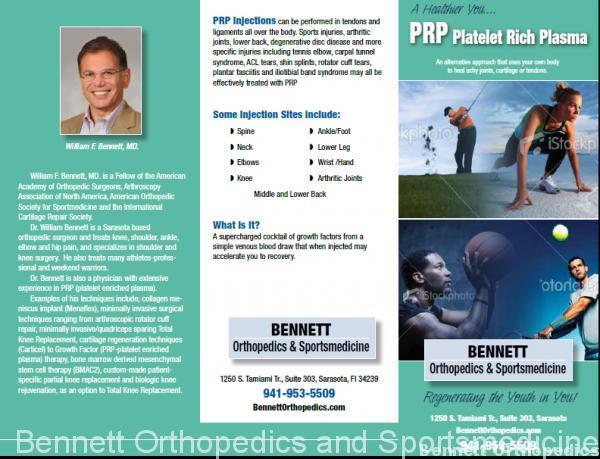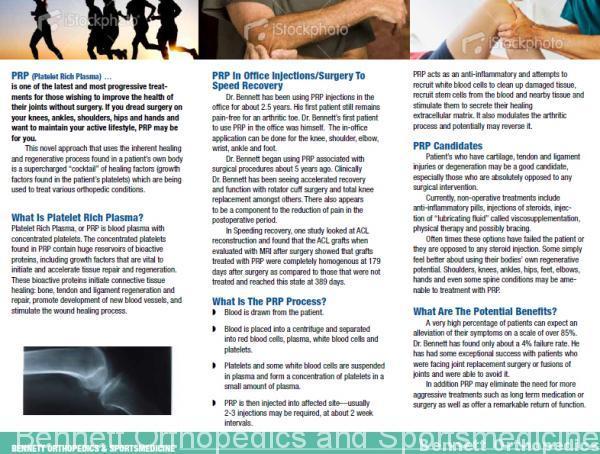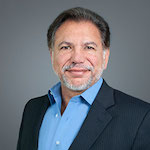Adult Stem Cell Therapy & Platelet Rich Plasma
PRP for Sports Injuries and Treatment
PRP has been utilized in veterinary and dental medicine for decades. Heart and Plastic Surgeons have been incorporating in their work for a decade. Orthopedics is a newer player to incorporate its use. Interestingly, early on in Orthopedics, after PRP-which is a concentrate of platelets made from your own blood and after discarding most of the red blood cells and most of the plasma which is devoid of most of the platelets- was discarded, yes!, initially this component was actually discarded, as surgeons were interested in the platelet poor plasma…….and when activated-………would create a semi-autologous fibrin glue which both aided in clotting and sealing surgical defects= orthopedic surgeons began to realize the benefit of the concentrated platelets.

Many animal studies have shown that concentrated platelets (simplified) can stimulate collagen production form tendon and ligament cells and stimulate cartilage cells to produce cartilage, bone cells to produce bone and muscle cells to produce muscles.
This has been extrapolated to the use in humans and has been found to be clinically helpful in treating injuries in athletes.
Dr. Bennett has been treating sports injuries with PRP injections for 8 years, firstly, with surgical procedures, later as straight-forward in-office injections. The lay public began to hear about PRP with the Wall Street Journal article, March 30, 2010 which outlined the names of numerous athletes who had been treated with PRP for their injuries.

Not all PRP is the same.
PRP can be de-activated with anesthetic agents. In fact, a blood draw from the same patient at various times during the day may only make PRP 2 out of 3 times.
Most of the time, PRP can be utilized as an injection for injuries ranging from cartilage injury to osteoarthritis, to tendon and ligament injuries. Fibrin scaffolds can be created from plasma and can be utilized to keep platelets in a certain injury location.

Most understand the beneficial effect of Testosterone to aid in keeping our musculoskeletal system strong and healthy and keep muscle mass.
What many athletes don’t realize is that testosterone helps mainly the muscle component of the musculoskeletal system and bone, but, does not help much to help the tendon or ligaments. As muscle mass increases and has a better ability to handle increased loads, the tendon which connects the muscle to the bone may not be in a healthy state to withstand these increased forces.
Interestingly, IGF-1 is a component of PRP and has been shown to be beneficial to stimulating tendon and ligaments to secrete collagen, creating healthier tendons and ligaments.

There is controversy with the use of Human Growth Hormone and for the most part is not allowed by athletic use. It has no real performance enhancing function. However, its efficacy is measured by measuring IGF-1 in blood. Now if systemic IGF-1 was increased, could this help our tendons and ligaments avoid injury?
There are animal models which, indeed, show that the administration of systemic IGF-1 with or without Human Growth Hormone can help tendon and ligament health.
For athletes over 40 years of age and after failing a somatorelin pituitary challenge test, adult human growth hormone deficiency is, at times, documented, and when present, adults over 45 or retired athletes may take human growth hormone legally and under a physician’s prescription, if after a somatorelin challenge test their pituitary does not respond by making growth hormone or elevating IGF-1 levels. This office does not prescribe HGH for any patient.
PRP Pricing
Please be aware the PRP Procedure price DOES NOT include the office visit or the ultrasound. Most insurance companies do NOT typically pay for PRP procedures. We will bill your insurance company for the office visit (99213 or 99214) and the ultrasound (76681). If your insurance should apply any amount of those charges to patient responsibility (copay, coinsurance, deductible, etc.) then you will be responsible for those charges. The price of the PRP covers the cost of the PRP kits, Centrifuge, processing, Local Anesthesia, Phlebotomist and the actual procedure of injecting the Platelet Rich Plasma.






